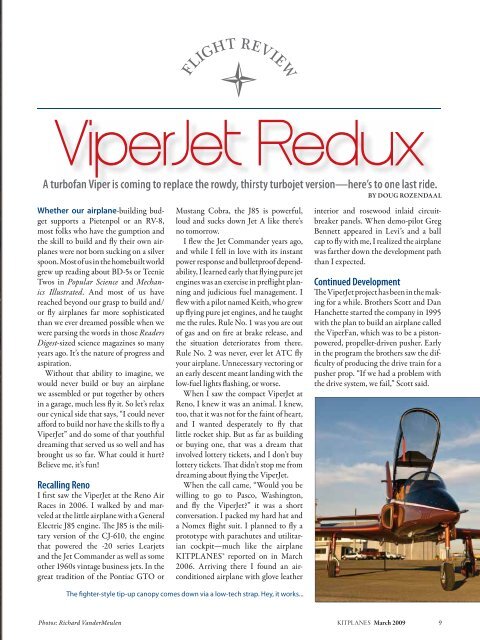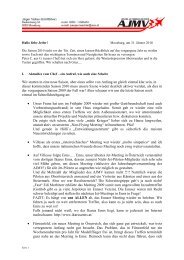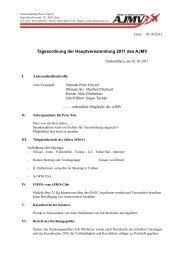A turbofan Viper is coming to replace the rowdy, thirsty ... - AKATEC IT
A turbofan Viper is coming to replace the rowdy, thirsty ... - AKATEC IT
A turbofan Viper is coming to replace the rowdy, thirsty ... - AKATEC IT
You also want an ePaper? Increase the reach of your titles
YUMPU automatically turns print PDFs into web optimized ePapers that Google loves.
<strong>Viper</strong>Jet Redux<br />
A <strong>turbofan</strong> urbofan <strong>Viper</strong> <strong>is</strong> <strong>coming</strong> <strong>to</strong> <strong>replace</strong> <strong>the</strong> <strong>rowdy</strong>, <strong>thirsty</strong> turbojet version—here’s <strong>to</strong> one last ride ride.<br />
Whe<strong>the</strong>r our airplane-building budget<br />
supports a Pietenpol or an RV-8,<br />
most folks who have <strong>the</strong> gumption and<br />
<strong>the</strong> skill <strong>to</strong> build and fl y <strong>the</strong>ir own airplanes<br />
were not born sucking on a silver<br />
spoon. Most of us in <strong>the</strong> homebuilt world<br />
grew up reading about BD-5s or Teenie<br />
Twos in Popular Science and Mechanics<br />
Illustrated. And most of us have<br />
reached beyond our grasp <strong>to</strong> build and/<br />
or fl y airplanes far more soph<strong>is</strong>ticated<br />
than we ever dreamed possible when we<br />
were parsing <strong>the</strong> words in those Readers<br />
Digest-sized science magazines so many<br />
years ago. It’s <strong>the</strong> nature of progress and<br />
aspiration.<br />
Without that ability <strong>to</strong> imagine, we<br />
would never build or buy an airplane<br />
we assembled or put <strong>to</strong>ge<strong>the</strong>r by o<strong>the</strong>rs<br />
in a garage, much less fl y it. So let’s relax<br />
our cynical side that says, “I could never<br />
aff ord <strong>to</strong> build nor have <strong>the</strong> skills <strong>to</strong> fl y a<br />
<strong>Viper</strong>Jet” and do some of that youthful<br />
dreaming that served us so well and has<br />
brought us so far. What could it hurt?<br />
Believe me, it’s fun!<br />
Recalling Reno<br />
I fi rst saw <strong>the</strong> <strong>Viper</strong>Jet at <strong>the</strong> Reno Air<br />
Races in 2006. I walked by and marveled<br />
at <strong>the</strong> little airplane with a General<br />
Electric J85 engine. Th e J85 <strong>is</strong> <strong>the</strong> military<br />
version of <strong>the</strong> CJ-610, <strong>the</strong> engine<br />
that powered <strong>the</strong> -20 series Learjets<br />
and <strong>the</strong> Jet Commander as well as some<br />
o<strong>the</strong>r 1960s vintage business jets. In <strong>the</strong><br />
great tradition of <strong>the</strong> Pontiac GTO or<br />
Pho<strong>to</strong>s: Richard VanderMeulen<br />
Mustang Cobra, <strong>the</strong> J85 <strong>is</strong> powerful,<br />
loud and sucks down Jet A like <strong>the</strong>re’s<br />
no <strong>to</strong>morrow.<br />
I fl ew <strong>the</strong> Jet Commander years ago,<br />
and while I fell in love with its instant<br />
power response and bulletproof dependability,<br />
I learned early that fl ying pure jet<br />
engines was an exerc<strong>is</strong>e in prefl ight planning<br />
and judicious fuel management. I<br />
fl ew with a pilot named Keith, who grew<br />
up fl ying pure jet engines, and he taught<br />
me <strong>the</strong> rules. Rule No. 1 was you are out<br />
of gas and on fi re at brake release, and<br />
<strong>the</strong> situation deteriorates from <strong>the</strong>re.<br />
Rule No. 2 was never, ever let ATC fl y<br />
your airplane. Unnecessary vec<strong>to</strong>ring or<br />
an early descent meant landing with <strong>the</strong><br />
low-fuel lights fl ashing, or worse.<br />
When I saw <strong>the</strong> compact <strong>Viper</strong>Jet at<br />
Reno, I knew it was an animal. I knew,<br />
<strong>to</strong>o, that it was not for <strong>the</strong> faint of heart,<br />
and I wanted desperately <strong>to</strong> fl y that<br />
little rocket ship. But as far as building<br />
or buying one, that was a dream that<br />
involved lottery tickets, and I don’t buy<br />
lottery tickets. Th at didn’t s<strong>to</strong>p me from<br />
dreaming about fl ying <strong>the</strong> <strong>Viper</strong>Jet.<br />
When <strong>the</strong> call came, “Would you be<br />
willing <strong>to</strong> go <strong>to</strong> Pasco, Washing<strong>to</strong>n,<br />
and fl y <strong>the</strong> <strong>Viper</strong>Jet?” it was a short<br />
conversation. I packed my hard hat and<br />
a Nomex fl ight suit. I planned <strong>to</strong> fl y a<br />
pro<strong>to</strong>type with parachutes and utilitarian<br />
cockpit—much like <strong>the</strong> airplane<br />
K<strong>IT</strong>PLANES® reported on in March<br />
2006. Arriving <strong>the</strong>re I found an airconditioned<br />
airplane with glove lea<strong>the</strong>r<br />
The fi ghter-style tip-up canopy comes down via a low-tech strap. Hey, it works...<br />
BY DOUG ROZENDAAL<br />
interior and rosewood inlaid circuitbreaker<br />
panels. When demo-pilot Greg<br />
Bennett appeared in Levi’s and a ball<br />
cap <strong>to</strong> fl y with me, I realized <strong>the</strong> airplane<br />
was far<strong>the</strong>r down <strong>the</strong> development path<br />
than I expected.<br />
Continued Development<br />
Th e <strong>Viper</strong>Jet project has been in <strong>the</strong> making<br />
for a while. Bro<strong>the</strong>rs Scott and Dan<br />
Hanchette started <strong>the</strong> company in 1995<br />
with <strong>the</strong> plan <strong>to</strong> build an airplane called<br />
<strong>the</strong> <strong>Viper</strong>Fan, which was <strong>to</strong> be a p<strong>is</strong><strong>to</strong>npowered,<br />
propeller-driven pusher. Early<br />
in <strong>the</strong> program <strong>the</strong> bro<strong>the</strong>rs saw <strong>the</strong> diffi<br />
culty of producing <strong>the</strong> drive train for a<br />
pusher prop. “If we had a problem with<br />
<strong>the</strong> drive system, we fail,” Scott said.<br />
K<strong>IT</strong>PLANES March 2009 9





